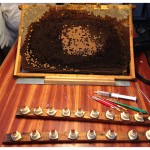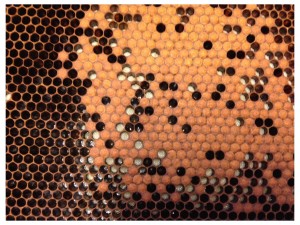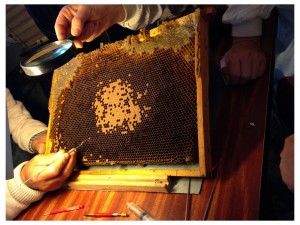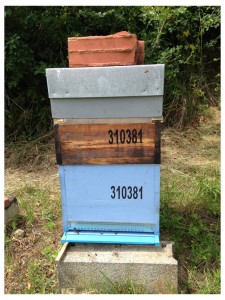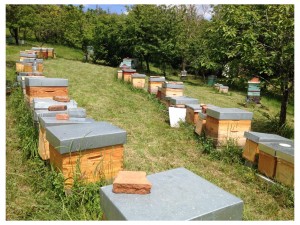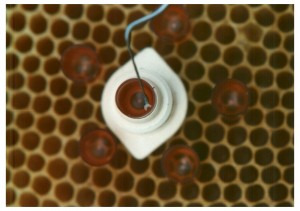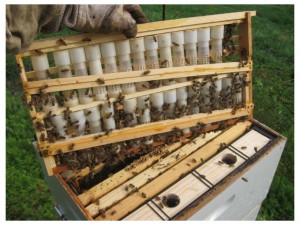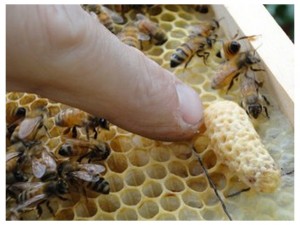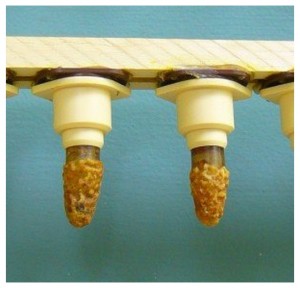The hive is in full south facing sun all day and protected from wind. They took 6 weeks to draw out the 2-3 new frames in a 10-frame super even with me feeding syrup and when I put the second super on in July not a single frame has been drawn out, even with two lower frames put up top. The frames have plastic foundation, so maybe they hate it. No burr comb either. Weird.They are super protective – not African-ized, but pretty damn mean. I wrote the keeper that I got the nuc from and he sent me a note in return saying that this is “normal behavior” for his survivor bees. It is not a lack of resources or the queen: she is a brood making machine with very few drone cells. They are just kind of mean.
Tag: Hive
Film Friday – BEES!!
My wife bought me a package bee hive box kit for Christmas last year, which reinforces the fact that I have a wife that is kind and considerate and pretty damn adorable.
Anywho, I thought that installing a new hive would be a terrific opportunity to document all the steps to install bees into a new hive box. I went with a nuc hive instead of packaged bees and a new queen. That is for a later video. The whole process of bringing a new hive into the apiary also allowed me to show all the steps in prepping the pre-built hive boxes/parts and I was able to build and showcase a couple of steel hive stands that I have been thinking about and designing in my head for years. I will also make a video on the design and build of the hive boxes and parts, but that will have to wait until this winter.
I love bees and I love being a beekeeper. The honey isn’t bad either…
Beekeeping – Making New Queens
A couple weekends ago I worked the hives, checking their overall health and seeing if any were thinking about swarming. Swarming = bad. If there is more than one Queen in a hive, the ladies will either duke it out and both could die – dead hive bad – or the hive will swarm, taking possibly more than half of the precious worker bees that make all the yummy honey. There are some things that can be done to prevent swarming:
1. If two queens are found or if there are new queens about to be born (they have a uniquely shaped chamber that other bees make specifically for queens) AND the hive is doing really well, you can manually split the hive into two hive boxes.
2. If the hive is not doing great, remove the old queen and let the new one be born.
3. If the hive is doing fine and you don’t want another, then you can snip the new queen chamber in half – assuring that the original queen will preside a little longer.
Sometimes though, you will need a new queen if old one not producing, she dies unexpectedly, if the hive is aggressive, etc… When this happens, you typically buy/order a new one from your local bee supply store, online, or from a local apiarist who makes a little side money raising them in specially maintained hives. I had never actually witnessed the process of “Making Queens”, so when one of the older gents with Syndicat Apiculteur, held a lecture after the hives were checked, I sat in and tried my hand at it.
The simplified version:
1. Take a fresh brood comb out of a gentle hive that is doing well and has historically been a great honey producer.
2. Prepare “Queen Cups” with Royal Jelly.
3. Gather lights and tools and an assortment of magnifying glasses.
4. Uncap the comb and prop it under a light on a 45 degree stand.
5. Make sure no bees are in the room as an uncapped brood comb WILL piss them off and you WILL get stung.
6. Remove any stingers from skin while quietly cursing.
7. With a small dental scoop, remove one larva per cup. Look for a small one no larger than 1.5mm.
8. When cups are filled, place in special “Queen Frame”
9. Place frame in hive with no Queen – there is more to it than that, but for the sake of brevity…
10. Add a sugar water mixture to a feeder frame next to the “Queen Frame” in the hive.
11. Check back and when the queen cells are fully closed and the new queens are growing, place a purpose built cage over the cell and wait for them to emerge.
12. Re-queen some hives or sell them to your nerdy bee-keeping friends.
